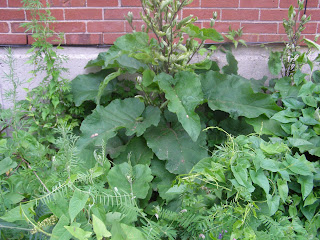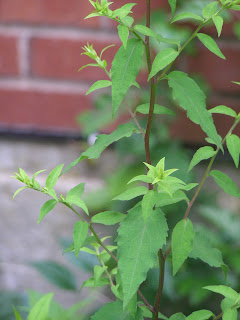 |
| These vaguely thistle-shaped leaves belong to prickly lettuce, also known as wild lettuce, |
 |
| Now, this is a thistle! |
 |
| This wire-thin grass is path rush. It specializes in pavement cracks. Here, it will carry out its life-cycle in competition with more then forty other species. |
 |
| Path rush among others. |
 |
| This yellow wood-sorrel has established a foothold against the other building hard by this small, neglected space. |
 |
| A young plant with deeply lobed leaves is growing into what I do not yet know. |
 |
| Young horse weed plants fight to establish a foothold among the competing vetch, goldenrod, and wild morning glory. |
 |
| Goldenrod, like the others, fights to establish dominance over its own claimed patch. |
 |
| A dandelion puts forth leaves in a vegetatively desperate attempt to flower and produce seed. |
 |
| Bold clover leaves put in their own bid for reproductive possibilities. |
 |
| A strikingly boldly colored black and orange caterpillar grazes among the leaves. |
 |
| A vetch flower blooms amid hawthorn and fireworks weed leaves, |
 |
| Goldenrod leaves are building to future yellow flowers. |
 |
| The poke weed puts out leaves to drink in the energy of the sun. This will fuel the lavish production of flowers and berries to come. |
 |
| Pansies bloom in a somewhat incongruous container standing in a corner of the garden. |
 |
| A pretty 'face". |
 |
| Some other pretty faces, a bit small for pansies, but nevertheless drinking in the sun's light. |
 |
| Last year's mullein spikes. |
 |
| A closer view |
 |
| Really close |
 |
| I called this vine-like plant false hops when I first saw it, but this is the mulberry, showing off some of its many leaf forms.. |
 |
| The honey-sweet scented milkweed flower smells as pretty as it looks.. |
 |
| Embattled milkweed blooms between sharp competitors, |
 |
| Here we see an array of leaves as many species vie for a foothold in this small space. |
 |
| This plant looks like white heath aster, but it is blooming in June. The flowers are cupped like those of the white heath aster, not flat like those of daisy flea bane. Do you know what this is? |
 |
| Could this be early blooms of daisy flea bane that will later open out flat, or is it another sort of aster? |
 |
| Here is more of this rather puzzling aster. |
 |
| The hawthorn leaves would look tender and tasty, if I were the right sort of caterpillar! |
 |
| The hawthorn is competing successfully with a number of other species. |
 |
| Some raspberries are long gone, but a young fireworks weed is growing straight up.Do you know the proper name of this plant? |
 |
| A young mug-wort is putting in a strong bid for this bit of soil. |
 |
| Bittersweet looks so innocent when it is first growing, Do not be fooled! |
 |
| Bittersweet is a vine that will coil around and strangle other plants. It can take over a lot of territory! |
 |
| The curly dock is in bloom. |
 |
| Large, slightly curly leaves announce the presence of a burdock, just starting to develop its flower heads. |
 |
| Close up, the large supporting leaves can be seen to contrast with the smaller leaves of the upper growth. |
 |
| This broad-leaved grass would appear to be nimblewill. You will see the seed heads later on. |
 |
| Black raspberry appears to bloom early and often. Any ripe berries that appear are soon eaten! |
 |
| Raspberries also are growing in this garden. |
 |
| Bindweed, or wild morning glory, grows profusely in this garden. The flower seen above is actually from a nearby garden. |
 |
| Tree-of-heaven leaves are already drinking in the sun. |











